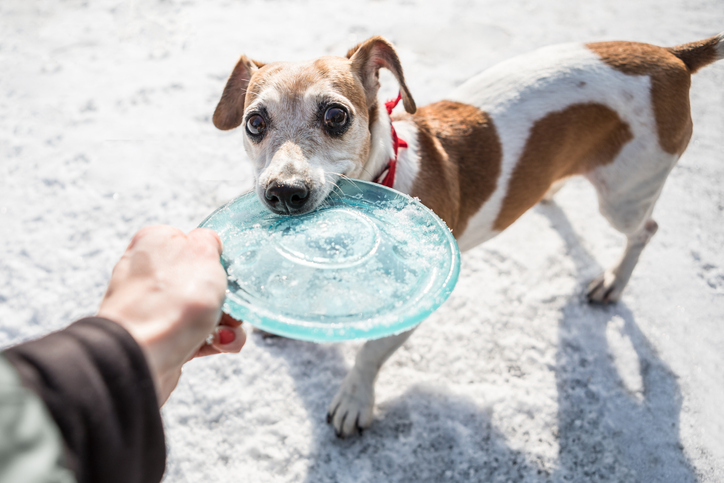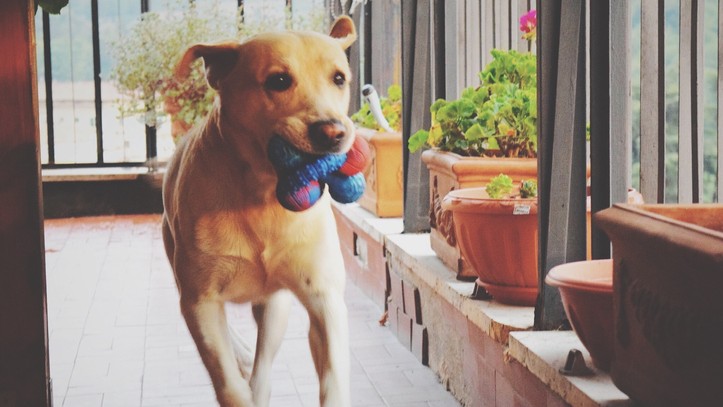My dog is possessive over toys. What can I do?
If your dog is possessive over toys, here’s everything you need to know to get them to share

If your dog is possessive over toys and snapping or growling when you approach them, it’s behavior that you need to tackle. Toys are not just fun for your dog. They can be used to help train them, to ensure they get enough exercise and to help them explore natural instincts and behaviours such as chasing or hunting. You can make sure your pooch is mentally and physically stimulated by researching the best dog toys and making sure they enjoy them. However, if your dog is exhibiting possession aggression or resource guarding aggression – showing threatening behaviour such as growling or snapping when someone tries to touch their toys – this could escalate and lead to unwanted actions such as biting or fighting with other dogs. This guide will help you nip this type of reaction in the bud so that being possessive over its toys doesn’t become a bigger problem.
- Best rope dog toys
- How to stop a dog stealing toys
- Best durable dog toys: Tough toys they can't destroy
- How to wash dog toys: Everything you need to know
Why is my dog possessive over toys?
It’s important not to worry if your dog has become possessive over its toys. While you don’t want your pet showing aggressive behaviour, possessive aggression or resource guarding aggression is perfectly natural as long as it is managed so that your dog isn’t biting you or losing control. Dogs are descended from wolves, who are accustomed to guarding their prey from the threat of other predators so when your pet guards their toys, they are simply using their instincts. They fear their toys will be taken away from them or that they will be punished.
Dogs can exhibit this type of behaviour for a number of reasons. It can be a learned behaviour from their mother or litter mates, an acquired behaviour if your dog was mistreated in the past if, for example, it grew up in a shelter or it can develop when a new dog enters the home and they feel threatened.
It can also happen in a good home, however. Often it will start with a fun game where you’re playing with your dog and its toy and they learn that it’s fun to steal the toy from you as you encourage it with positive reactions. Then if your dog is bored or not getting enough attention, they will use this learned behaviour.
Similarly, if your dog hasn’t been trained or socialised properly and they have a dominant character, or if they have not been given any boundaries and they’re used to getting what they want, this could cause possessive aggression.
If you’re not sure why your dog is behaving this way, check with your vet as it could be a result of something else such as a medical reason, inbreeding or sexual maturation.
Why do dogs love their toys?
We give our dogs toys for mental and physical stimulation and just like our children, they love their toys. It not only gives them something to do, as often dogs thrive when they have a job to do, but it can be fun and comforting – just like a young child enjoys playing with and being comforted by a doll.
Different breeds prefer different toys and it all comes down to shape, size, texture, sound and taste as they not only explore their senses, but their instincts. Just like the wolves they are descended from, dogs enjoy exhibiting natural wild behaviours , which can be simulated using their toys. They play fetch and chase toys as if they were hunting, they use squeaky chew toys and tear apart plush toys as if they were prey. This can help relieve them of boredom or stress, they can bond with their owners with games such as tug of war or enjoy exploring with puzzle games. Toys provide them with plenty of dog enrichment to keep them entertained so why wouldn’t they love them?

What do I do if my dog is possessive of its toys?
If your pup is hoarding its toys, refusing to give them up and showing aggression such as growling or even biting, this is unacceptable behaviour, but it can be stopped. The most important thing to do is not to force your dog to give up their toy. They will just end up running away and holding on to the toy even tighter. Instead, you want to teach them to give it up themselves using one of these methods:
Reward good behaviour
If your dog doesn’t want to give up its toy, the easiest way to convince them to do so is by showing them that if they do give it up they will be rewarded. This could be in the form of a treat (try these best dog treats) or a new toy. Once they have given up the toy, it’s a good idea to return it to them to show them they do not need to guard their toys and that they can trust you.
Give them an alternative
If they’re being possessive, the aim is to give them something else to be interested in or occupy their attention. Try to train your dog with the phrases ‘leave it’, ‘drop it’ and ‘swap it’. Give them something in return for dropping their toy and reward them with praise. They will soon learn not to fear losing their toys as there are lots of alternative options.
Desensitisation and counter-conditioning
Your dog isn’t giving up its toy out of fear so the aim is to make them associate the situation with something more positive and to change their emotional response. Avoid direct confrontation, entering their personal space, shouting or punishing your pet. Instead throw bits of cheese, liver or sausage (something they want more than the toy) towards your dog one after the other and quickly. Once it’s dropped the toy and shown interest in eating the food, throw some more pieces away from the toy. When they move to eat this, retrieve the toy. Week-on-week you should be able to gain their trust and get closer and closer to them so that they trust you and feel happier to move away from their toys.
Use toys in training
By using toys in training you can teach your dog not to be possessive, to retrieve their toys and bring them to you, their owner. Use commands such as ‘take it’ or ‘leave it’ and then reward them with treats or praise so they learn not to guard their toys. You can make this more fun by playing a game of tug of war. Reward your dog when they pull their toy away from you, then let go and tell them how smart and strong they are. Hold your hand out to take the toy back while praising them again. They should find this game fun and learn not to be afraid to give up their toy, as they will get it back.
When training your dog, make sure to be the leader and get your dog to work for everything that they want. This way they will know that you are in charge and it will be easier to train them to drop their toys on command.
Encourage positive play
Your pet is guarding his toys out of fear so your aim is to make all interactions positive ones. Instead of shouting at them, use positive reinforcement. Stay relaxed and congratulate your dog on their trophy. They may drop the toy if they think they are being praised and rewarded for holding on to it.
How do you stop a dog from being jealous of toys?
Is your dog jealous of dogs in the park and their toys or a new companion at home? This can lead to fighting so it’s important to address so they’re not showing aggression to other dogs. If you’ve brought a new pup home there’s a number of things you can do to stop jealous behaviour. Firstly, make sure you’re not giving your new dog too much attention and neglecting your other dog. You want to show them equal treatment. This means getting two of everything so there is less reason for them to be jealous and treating them the same way. Remember to praise and reward good behaviour and ignore unwanted behaviour. If you’re seeing jealous behaviour, keep a diary of when and how it happens so you can learn how to respond. Train both dogs to feel safe in their crates in case they need a time out from each other. If both pets feel loved and get enough attention it should be an easy problem to solve.
Whether at home with a new dog or out with other dogs, if your pet is showing jealous behaviour you can train them to share. Start by keeping them on the leash at first. Give the other dog a treat and when they go towards it, give the jealous dog a treat and say ‘share’. You can also use the commands ‘first’ and ‘wait’ to teach them they can play with the toy next and that they have to be patient. Repeat this several times and your pup will start to learn that there is no threat in sharing toys.
Here are some games to play with dogs, recommended by a behaviorist. Want to get to the bottom of your dog play barking? A behaviorist explains the real reasons.
PetsRadar Newsletter
Get the best advice, tips and top tech for your beloved Pets

